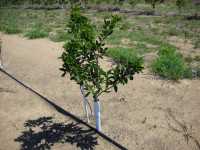Data Plan Desperately Needed To Track Early Citrus Plantings

Growers considering an investment in new citrus varieties are requesting statistical information that is either unavailable or has not yet been cobbled together from multiple sources. Current information systems may not completely address the need, and it may be time for some “out of the box” thinking.
Many growers are expressing an interest in replanting, but in the face of current challenges are likely to move cautiously and slowly. Factors such as nursery capacity and disease pressure further ensure that replacement acreage will come in smaller increments than originally hoped. As new fresh varieties enter this picture, Florida’s tree inventory will be a mile wide and an inch deep. This is to say, we will have more varieties than in the past with less overall tree count and acreage. Eventually (God willing), acreage will increase to target levels. But in the meantime, the assimilation of crop statistics will be challenging.
Information Gap
Current production and tree-count statistics are efficiently collected when variety volume approximates 1 million boxes. When production is under 1 million boxes, and the plantings are widely dispersed, it is difficult to efficiently include them in the USDA-National Agriculture Statistics Service (NASS) program. This is one of the reasons that select varieties were removed from the program in the past. It is a reasonable assumption that fresh specialty and grapefruit hybrid plantings will not be in sufficient quantity for inclusion in the traditional statistical program.
We might need to exclude specialty and other varieties from the program until they are produced in sufficient quantity to justify inclusion. Such exclusion would cause us to look to other available sources of information for answers. FDACS-DPI’s Bureau of Budwood Registration produces data on varietal propagations. This report is done annually and provides a helpful snapshot of variety and rootstock production at the nursery level.
The Florida Department of Citrus collects variety information on its tax forms — but this is only helpful with regulated varieties that incur assessments. Tax forms might not tell the entire picture. Additionally, reports on packed volume alone lack depth as growers need some idea about producing acreage and planted-but not-yet-producing acreage.
The Florida Department of Agriculture collects data from shipping manifests that is broken down by variety. Again, packed volume by variety is helpful, but not sufficient. New Varieties Development & Management Corp. (NVDMC) has information about varieties managed within its program, but not all varieties will be under NVDMC.
Progress Report
Although there will be more discussion of this issue over the next couple months, it appears that propagation reports from the Bureau of Budwood Registration, presented in a modified format, may be our best source of information for emerging varieties. Data on variety propagations, presented over multiple years and showing cumulative tabulations and factoring in accepted standard attrition rates, may be the most effective means of tracking the progress of new material. If combined with pack-out data, this should sufficiently inform grower decisions until or if the variety reaches sufficient volume for inclusion in the NASS program. If you have an idea that would improve this process, please send me a note.










